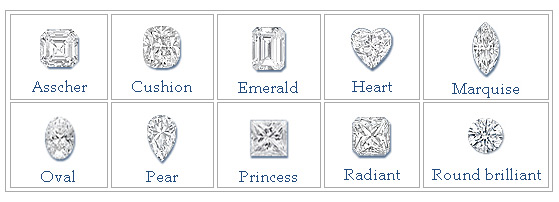While you sometimes hear the words shape and cut used interchangeably (even we do it), they are actually two very different things. Diamond shape means just that: the shape or look of the diamond. On the other hand, the cut of a diamond refers to the proportions, symmetry, and finish of a gemstone. When combined, these three characteristics are generally referred to as the "make" of the diamond.

Diamond Shape
Despite technically being different than the cut, the shapes of diamonds are commonly referred to using the word cut. For example, you'll frequently hear phrases like "princess cut" or marquise cut".
Your individual style and taste are the only factors that should be taken into account when choosing your diamond's shape. The most popular shapes, especially in diamond eternity bands and other diamond wedding bands, are round brilliant and princess. While there are other, less common shapes, we've listed the 8 shapes you're most likely to run into when diamond shopping.
Asscher Cut Diamond
Developed by the Asscher Brothers in Holland in 1902, the "Asscher cut diamond" is a stepped square diamond with cropped corners. It is also known as a "square emerald cut".
Cushion Cut Diamond
The "cushion cut diamond" is an antique style. Its shape is generally square or rectangular with rounded corners. It is sometimes referred to as "pillow-cut" or "candlelight diamond".
Emerald Cut Diamonds
"Emerald cut" diamonds are rectangular in shape with cut corners. Its concentric, broad, flat panels that resemble stairs make this a stepped cut. Look for superior clarity when buying an "emerald cut" stone because the openness of the cut means that inclusions and other flaws are easier to see. This shape got its name because it was originally developed for cutting emeralds.
Heart Cut
Frequently chosen due to its romantic symbolism, "heart cut" diamond are basically "pear cut" diamonds with a cleft at the top. The beauty of this cut depends on the skill of the cutter and is enhanced by an even shape and a well-defined outline.
The Marquise Cut
King Louis XIV of France commissioned a diamond to match the fetching smile of Jeanne Poisson, Marquise de Pompadour. The result was what is now known as the "marquise cut". The elongated shape with pointed ends is sometimes compared to an American football.
Oval Cut Diamonds
"Oval cut" diamonds are even and perfectly symmetrical. Its elongated shape is popular with women who have small hands or short fingers because it gives a flattering illusion of length to the hand.
Pear
This diamond teardrop shaped hybrid cut is half "oval cut" and half "marquise cut". While more common in pendants and earrings, this shape is another choice popular with women who have small or average-length fingers.
Princess
This square or rectangular shape is cut with many sparkling facets. Most square cuts can't compare to "round brilliant cut" stones' sparkle. However, the "princess cut" was designed for getting maximum brilliance. If you choose a "princess cut", ensure that the corners are protected by the setting. "Princess cut" diamonds tend to be quite deep.
Radiant Cut Diamonds
"Radiant cut" diamonds also tend to be deep. Like and "emerald cut" or "Asscher cut" diamond, it has cropped corners. However, like the "princess cut", it is also designed to maximize brilliance and tends to be quite deep.
Round Brilliant Cut
Given that "round brilliant cut" diamonds set the standard for other diamond types, it's not surprising that it is the most common diamond shape for wedding bands. It accounts for more than 75% of diamond sales. Its 58 facets are precisely calibrated to achieve the maximum in both fire and brilliance.

